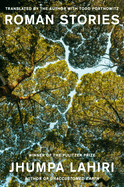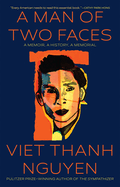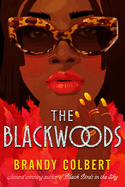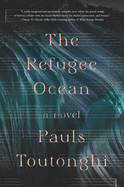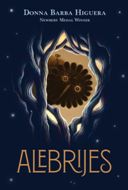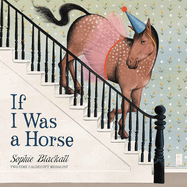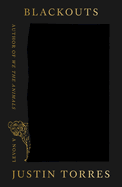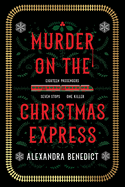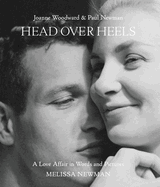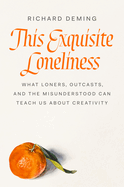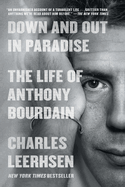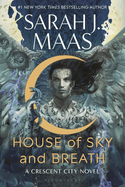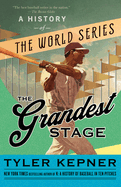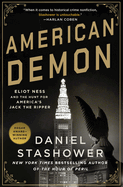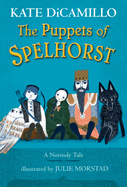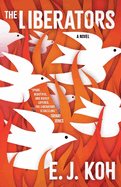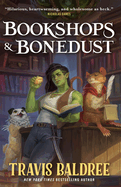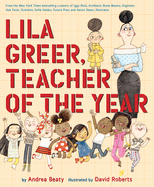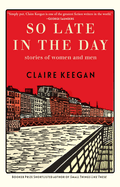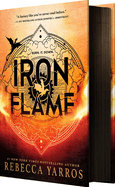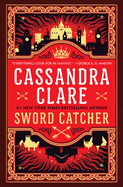Friday, October 13, 2023
Among the standout fiction this week: Roman Stories, Jhumpa Lahiri's story collection originally in Italian and translated by Lahiri and Todd Portnowitz, "showcases nine devastating short works on the immigrant experience in Italy"; Australian author Helen Garner's The Children's Bach, a "mesmerizing" novel about nine lives in 1980s Melbourne and the events that challenge one family's preconceived notions; and The Blackwoods by Brandy Colbert, a "beautiful narrative told from three different points of view," as two teen cousins from a prominent family learn how to navigate their celebrity lifestyle. Plus so many more!
And don't miss Kate DiCamillo in The Writer's Life, speaking about her novel The Puppets of Spelhorst (reviewed in this issue), the first in a planned trilogy.
Roman Stories
by Jhumpa Lahiri, transl. by Jhumpa Lahiri and Todd Portnowitz
The perpetual quest for defining elements one can call one's own--an identity, a family, a country--has long been the subject of Jhumpa Lahiri's writing, and that dynamic deepens with her exceptional collection Roman Stories. Written in Italian and translated by Lahiri (Translating Myself and Others; Whereabouts; The Lowland) with Todd Portnowitz, these nine stories, all of them featuring unnamed protagonists, center upon characters who have moved to Italy from elsewhere--more than one refers to "their country"--and who are often in conflict with locals who don't accept them as readily as the protagonists have accepted their adopted land.
Boundaries, whether between peoples or countries, are at the center of each work, sometimes explicitly so, as in "The Boundary," in which a teenager's immigrant family rents out a guest house on the property for which her father is the caretaker, and she wonders what that week's privileged occupants "know about the loneliness here." In "The Reentry," two women, one white and the other darker-skinned, meet for lunch, where the latter is subjected to racist comments that are no less shocking for being coated in sugary words. In "Well-Lit House," an immigrant family is subject to abuse from neighbors when they move to the city's outskirts. "She looks at everything I look at every day," the teenager in "The Boundary" observes. "But I wonder what else she sees in them." The ability to see beyond the obvious is Lahiri's greatest gift, and she demonstrates it again in this marvelous work. --Michael Magras, freelance book reviewer
Discover: Jhumpa Lahiri's story collection, written originally in Italian and translated by the author and Todd Portnowitz, showcases nine devastating short works on the immigrant experience in Italy.
The Refugee Ocean
by Pauls Toutonghi
In his gloriously symphonic The Refugee Ocean, Pauls Toutonghi (Evel Knievel Days) weaves a literary counterpoint, presenting two seemingly unrelated narratives that interconnect by novel's end into a satisfying performance. Music--the playing, composing, commemorating of--provides the resonating refrain throughout. By 2014, Naïm's family's luck finally runs out after more than three years of war in Aleppo, Syria. A single blast obliterates their home--a building with 96 residents--leaving only Naïm and his mother alive. Beyond losing his beloved father and younger siblings, the tragedy also leaves him with half a hand--robbing the 14-year-old piano prodigy of his greatest joy. Naïm and his mother's odyssey of survival will eventually land them in Northern Virginia, relying on the sometimes-kindness of strangers.
Almost seven decades earlier, in 1948 Lebanon, music is also at the core of Marguerite Toutoungi's identity. She's fought against the constraints society has assigned to her gender, magnified by her father's demands for unquestioning obedience and her mother's helpless complicity, and yet she's managed to prove her musical prowess. She's expected to marry the prime minister's nephew; it's a union that will solidify her family's socioeconomic standing. But Marguerite has just been accepted to the most prestigious music program in Europe, to which she applied without her parents' knowledge, much less approval. Falling in love with a visiting Cuban heir could be her chance for freedom. As disparate as these trajectories might seem, Toutonghi skillfully layers together their stories, connected by a dying 90-year-old who keeps secrets inside her Steinway grand piano. Beyond unimaginable loss and repeated displacement, music creates a lingering legacy of inspiring tenacity. --Terry Hong, BookDragon
Discover: In the symphonic The Refugee Ocean, Pauls Toutonghi deftly uses music to connect his disparate characters--a 20th-century Lebanese runaway and a 21st-century Syrian refugee in America.
Queen Hereafter
by Isabelle Schuler
Ambition, passion, and fate combine in Isabelle Schuler's debut novel, the thrilling historical drama Queen Hereafter (published in the U.K. under the title Lady MacBethad). Raised in the newly Christian land of Alba but prophesied by her pagan grandmother to become a queen, Gruoch expects that she will marry a king and reclaim the lands of her deposed father. She devotes herself to being a strong queen who can protect herself and her people, and when she is betrothed to Duncan, the heir-elect, she willingly leaves her childhood love, MacBethad, to go to court and meet her destiny. But as her marriage approaches, a sudden upheaval shatters all of her plans, and she must find allies where she can and build her own fate.
Schuler smoothly weaves history and invention into a whole as layered with drama as anything by Shakespeare, with a healthy measure of Shakespearean references as a bonus. Gruoch's path is also as bloody and full of revenge as anything by the Bard of Avon. She withstands violence and returns it with interest. Many scenes are not for the faint of heart, but given that this is the origin story of the character we know from Macbeth, no spoilers are required to know that this stage of her life will end in triumph. Fans of Madeline Miller, Claire North, and other authors' stories of women in bygone days creating power for themselves through pure determination will be eager to see more from Schuler. --Kristen Allen-Vogel, information services librarian at Dayton Metro Library
Discover: A young woman's survival in medieval Scotland demands all the ambition and ruthlessness that would inspire one of Shakespeare's most memorable creations.
The Children's Bach
by Helen Garner
Helen Garner (This House of Grief; Monkey Grip) has long been celebrated as one of Australia's greatest authors, and U.S. readers will get to savor the brilliance of her work with several releases, including The Children's Bach. Written in 1984, this short novel is the portrait of, as Rumaan Alam puts it in his introduction, "the collision of several lives" in 1980s Melbourne. Garner has structured this work as an ensemble piece that shifts among perspectives, sometimes within a single scene, with no one character dominating. The result is a unique depiction of familial confusion in 20th-century Australia.
Among the characters in this mesmerizing work are Athena and Dexter Fox, a seemingly happy married couple with a piano in the kitchen; their sons, Arthur and Billy, the latter of whom has a developmental issue and screams when provoked ("There's nobody in there," Athena complains); Dexter's college friend Elizabeth, with whom he "lived almost as sister and brother for five years as students" and is now reacquainted after 20 years; Elizabeth's much younger sister, Vicki; and Elizabeth's married musician boyfriend, Philip, with whom she introduces the Foxes to a side of society that upends their lives. The book is filled with jewels of prose, such as: "All the objects in the room looked like cartoons of themselves: the flap-handled fridge, the brown piano grinning, the dresser where plates leaned and cups hung." Garner doesn't make her themes apparent, but, for patient readers, The Children's Bach offers a trove of riches. --Michael Magras, freelance book reviewer
Discover: Australian novelist Helen Garner's 1984 short novel focuses on nine lives in 1980s Melbourne and the events that challenge a family's preconceived notions.
Blackouts
by Justin Torres
More than a decade after We the Animals, his debut novel, Justin Torres returns with Blackouts, an enigmatic and thought-provoking puzzle box of a novel about the limitations of historical accounts and narrative. An unnamed narrator arrives at a mysterious facility called merely "the Palace" to keep company with Juan Gay, a dying man he once knew, and begins telling stories to pass the darkening hours. But Juan has a story to tell in return: one about himself and about Jan Gay, a queer researcher whose lifelong work was co-opted by others. Based on a real book from the early 1940s, Sex Variants: A Study in Homosexual Patterns, the snippets of Jan's life and research become entangled in a larger portrait of stories left untold.
Torres's novel is a fragmentary tale, both in the way it's told and in its thematic resonances. What can be gleaned from the fragments of a life? What kinds of connections can be imagined in the gaps? As the narrator and Juan talk, their conversations become snippets of stories woven together with visual artifacts, much in the style of W.G. Sebald. Torres juxtaposes shards of narrative with photographs and documents, as well as censored documents that visualize the blacked-out gaps that define subversive stories. In this way, Blackouts engages in a precarious balancing act between fact and fiction, challenging readers' perceptions of what they understand to be history and what is constructed. Rather than offering any easy answers, Torres, like Juan, poses the important questions: "isn't that what mystery is? Your blackouts, these erasures? Frustration as art?" --Alice Martin, freelance writer and editor
Discover: Justin Torres's much anticipated follow-up to his groundbreaking debut, We the Animals, is a Sebald-ian literary feat that challenges readers' expectations of traditional narratives.
Mystery & Thriller
Murder on the Christmas Express
by Alexandra Benedict
Don't be fooled by Murder on the Christmas Express's cozy cover: Alexandra Benedict (The Christmas Murder Game) presents a darkly disturbing Christmas mystery, perfect for fans of Ashley Winstead or Ruth Ware. The novel--which pays homage to classic Golden Age mysteries like those of Agatha Christie--depicts how quickly people's civilized veneers can devolve when trapped in precarious situations.
Roz Parker has just retired as a Met detective. Her former colleagues buy her a ticket on a fancy overnight sleeping car to Scotland so that she can spend Christmas with her pregnant daughter, Heather. The train passengers include a couple of reality-television stars, some college students, a few families, and an attractive lawyer. Heavy snow on the tracks threatens holiday plans, which causes tension for the travelers. And Roz becomes anxious about Heather, who goes into labor early. But when the train derails and someone is found dead in their sleeping car--with the door locked from the inside--it's going to take all of Roz's prowess to unravel the mystery, especially once the killer strikes again.
Benedict writes with an understanding of the evil that people are capable of, and Roz fears for Heather's life during a dangerously complicated delivery. Yet Murder on the Christmas Express still includes nods to the holiday and clever anagrams, which will keep readers guessing. Anyone who thinks of Die Hard as a Christmas movie is sure to enjoy this addition to the Christmas-mystery genre. --Jessica Howard, freelance book reviewer
Discover: In this dark Christmas mystery, a retired Met detective trying to get to Scotland is caught up in a series of deaths on a derailed sleeper train.
Science Fiction & Fantasy
The Hurricane Wars
by Thea Guanzon
Lifelong enemies must face each other--and their feelings--on and off the battlefield in Thea Guanzon's immersive, inventive, and electric romantic fantasy, The Hurricane Wars. In a setting inspired by her home in the Philippines, Guanzon deftly blends fantasy and reality, creating a world shaped by colonialism, violent storms, and aether magic. Talasyn is a soldier fighting for a homeland falling under the shadow of the Night Empire. Alaric is the son and heir of the Night Emperor, who is destined to complete the brutal conquest begun by his grandfather and continued by his abusive father. Both have been raised to know that their opponents want nothing more than to eliminate or subjugate their people. Guanzon makes it clear that Talasyn is in the right, but the heroine as well as readers are drawn to Alaric as the author cleverly humanizes him through moments of awkwardness, his surprising mercy, and his uneasiness with his father's orders.
Following an intense opening battle in which Talasyn faces off with Alaric and loses friends and her homeland, the remnants of her army hide in an island nation while they regroup. Those islands hold the secret to Talasyn's past, including the source of her magic. When she arrives, the plot pivots to one of political intrigue and complicated family dynamics, resulting in an alliance she could never have predicted. Guanzon's compelling debut novel combines epic battles, intricate world-building, and intense chemistry. The Hurricane Wars will have fans of Hannah Whitten, Rebecca Yarros's Fourth Wing, and Star Wars positively craving the sequel. --Suzanne Krohn, librarian and freelance reviewer
Discover: This romantic fantasy pairs ultimate enemies in an epic Philippines-inspired adventure that will appeal to fans of Fourth Wing and Star Wars.
Romance
The Burnout
by Sophie Kinsella
When her mountain of e-mails and work stress become too much to bear, Sasha Worth runs away and tries to join a convent, only to hit a brick wall--literally. The opening of The Burnout by Sophie Kinsella, which tackles a serious subject with humor, sets the tone for this rejuvenating rom-com.
After the wall incident, Sasha takes temporary leave from her job at a tech company. She travels to Rilston Bay, the seaside resort where she vacationed every year with her family as a child, though she hasn't visited in 20 years. She's now going during the off-season, but she'll have the beach to herself to practice the activities she envisions will make her healthier: yoga, meditating, communing with nature. She's shocked, however, to find her beloved resort is now run-down, with sketchy rooms and furniture. Her plans are further disrupted when the rude man she encountered on the train shows up as a guest at the same hotel. The two keep their distance, until they realize they can help each other heal as well as revitalize the resort itself.
Even when exhausted by life, Sasha is a classic Kinsella (My (Not So) Perfect Life; Finding Audrey; I've Got Your Number) protagonist: quirky, kind, and optimistic. Her relationship with Finn, the grumpy fellow hotel guest, refreshingly takes its time to build, allowing Sasha to find her own strength. Together the two rediscover simple joys like surfing, something they both did as children at Rilston. As their former instructor used to say, "you have to enjoy the ride. The ride is it." Kinsella reminds readers of the same when it comes to life. --Elyse Dinh-McCrillis, reviewer and freelance editor at The Edit Ninja
Discover: In this heartwarming rom-com, a woman overwhelmed by work and life takes a wellness break at a seaside resort and rediscovers what makes her happy.
A Winter in New York
by Josie Silver
Josie Silver (The Two Lives of Lydia Bird; One Day in December) is known for her cozy and delectable romances. A Winter in New York is no exception, leaning into the warm glow of unconditional love and family loyalty through the story of Iris and Gio. Iris, a former London chef, escapes her toxic ex-boyfriend and the grief of her mother's death. She arrives in New York City with only a handful of belongings, including her mother's photo album and super-secret gelato recipe. When she discovers the same storefront that's in a photo in her mother's album and identical-tasting gelato at the Belotti family's gelateria, memories, questions, and complications intrude in her new life. Gio Belotti confides in Iris that the gelateria is in danger now that his uncle, the only one who knows the recipe, has lost his memory, but Iris is unsure how to help the Belottis without breaking her mother's trust. Offering to assist Gio in re-creating the famous vanilla flavor, Iris finds herself hesitant to accept the Belottis' open arms and fierce love while keeping secrets from them. As Iris and Gio come closer to the recipe, they find themselves even closer to each other.
Silver combines New York's winter backdrop with sweet treats, heartwarming family gatherings, and glimmers of new love in this romance of second chances, forgiveness, and gelato. As Iris and Gio fight to overcome their pasts to save the business and their hearts, A Winter in New York brings together the magic of New York winters and true love. --Clara Newton, freelance reviewer
Discover: Josie Silver delivers a heartwarming holiday romance that brings two people together over a secret family gelato recipe.
Biography & Memoir
Head over Heels: Joanne Woodward and Paul Newman: A Love Affair in Words and Pictures
by Melissa Newman
For fans of movie nostalgia or memoirs of true romance, Head over Heels: Joanne Woodward and Paul Newman: A Love Affair in Words and Pictures is a satisfying coffee-table book that, in roughly 200 photos, honors years of cinema magic and an inspiring and abiding love. Melissa Newman, the middle daughter of Paul Newman and Joanne Woodward, writes that this oversize collection of almost entirely black-and-white photos, with quotes from the couple, is "my gift to them, to myself, and to you." The book captures Woodward and Newman's inarguable beauty throughout the decades, chronicling their prolific movie careers. Images include those taken by such iconic photographers as Richard Avedon and Gordon Parks; a few playful pictures show Newman and Woodward photographing each other, emphasizing the couple's deep love and respect.
"Sexiness wears thin after a while and beauty fades, but to be married to a man who makes you laugh every day, now that's a real treat," Woodward observed. Newman's passionate devotion to Woodward is on display, with a quote from him noting that "Joanne has always given me unconditional support in all my choices and endeavors, and that includes my race car driving, which she deplores. To me, that's love." A deeply poignant closing photo shows Woodward's elderly hand extending from a moth-eaten sweater toward a collage of love letters and telegrams, a 2023 re-creation of an earlier picture snapped in the '50s. --Cheryl McKeon, Book House of Stuyvesant Plaza, Albany, N.Y.
Discover: The daughter of Paul Newman and Joanne Woodward shares a captivating photo collection documenting the iconic romance and prolific careers of the two film stars.
This Exquisite Loneliness: What Loners, Outcasts, and the Misunderstood Can Teach Us About Creativity
by Richard Deming
A global pandemic is on the rise, wider in range than almost any other the world has seen. Yet, there is nothing to look at under the microscope, nothing to inoculate against, despite several countries, like the United Kingdom, Japan, and Germany, creating positions of power to help stem this disease, this ailment from which humans have suffered in the past and will again in the future. That disease is loneliness. Richard Deming (Touch of Evil), in his thoughtful book This Exquisite Loneliness: What Loners, Outcasts, and the Misunderstood Can Teach Us About Creativity, examines six artists and thinkers from the 20th century, moving deftly from grand to humble ideas on how to deal with one of humanity's colossal challenges: loneliness.
Despite being something that all humans have dealt with, loneliness "always feels personal," Deming writes, and this is precisely why he wants to shine a light on humanity's darkest idea: the one that says people are alone. He beautifully illustrates how readers can take this feeling of desperation and cultivate sensitivity and acknowledgment, and how they can begin to carve out their own self-worth and understanding of the world around and in them. Deming focuses on six creators--Melanie Klein, Zora Neale Hurston, Walter Benjamin, Walker Evans, Egon Schiele, and Rod Serling--and illustrates how these great minds grappled with loneliness and how they used this particularly vulnerable feeling to heighten their awareness and to generate a promise for brighter futures in the dark. Deming's book lives up to its name: its construction, its explorations, and its easy-to-read writing style are all exquisite. --Dominic Charles Howarth, book manager, Book + Bottle
Discover: This Exquisite Loneliness is a lyrical, inspiring, and necessary book in a time during which people must search for others as well as look inside themselves.
American Classicist: The Life and Loves of Edith Hamilton
by Victoria Houseman
By any stretch of the imagination, educator and author Edith Hamilton (1867-1963) led an extraordinary professional and personal life for her time--or any other. In American Classicist: The Life and Loves of Edith Hamilton, Victoria Houseman, a historian and associate professor in the Department of History and Philosophy at the University of Wisconsin-River Falls, delves into Hamilton's experiences in all their complexity. Written with meticulous research and a deep appreciation for its subject, the biography skillfully uncovers the many realms of Hamilton's influence during her life--which spanned the first two-thirds of the 20th century--and the layers of her legacy.
Hamilton had an unyielding determination to pursue education and intellectual pursuits during a time when such aspirations were deemed unconventional for women--as was her 40-year relationship with her partner, Doris Fielding Reid. The biography provides an engaging narrative of Hamilton's influential role in the academic world, including as headmistress at Bryn Mawr School, and her later contributions in bringing classical history and literature to a wider audience through such acclaimed works as The Greek Way and Mythology. What sets this biography apart is Houseman's presentation of Hamilton not only as a scholar of antiquity, but also as a person who thought deeply about the contemporary world around her. The author also provides a thoughtful accounting of the reappraisal of Hamilton's work in both its positive and negative incarnations. American Classicist is a thought-provoking read about an incomparable figure. --Elizabeth DeNoma, executive editor, DeNoma Literary Services, Seattle, Wash.
Discover: This captivating biography of prominent classicist Edith Hamilton explores her extraordinary professional and personal life.
Essays & Criticism
A Man of Two Faces: A Memoir, a History, a Memorial
by Viet Thanh Nguyen
A Man of Two Faces, a memoir by Pulitzer Prize-winning novelist Viet Thanh Nguyen (The Committed; The Refugees), is a dizzying emotional and intellectual journey through the author's life and heritage as a refugee from Vietnam, raised primarily in San Jose, Calif. With daring formal experimentation that blends traditional memoir, personal and critical essays, and blank-verse poetry, Nguyen tells his story as a Vietnamese refugee and American, as a person of many worlds who can live but one life, and as a proud American with many reasons to despise so much of what the U.S. has done and continues to do.
Nguyen's story, unshackled from linear time or a conventional first-person perspective, voyages through, among many other things, his childhood and the many micro- and macroaggressions he faces as an Asian in America; the lives and worlds of his parents and ancestors; his rapturous and sorrowful academic findings; his extraordinary literary success; and a substantial body of critical theory and colonial history. The result is a remarkable array of deeply felt experiences, intellectual discoveries, and withering dark comedy, driven by clear, unrelenting, and head-throbbing prose that delivers a blistering call for multiracial and decolonial justice. A Man of Two Faces is a courageous and brilliant confrontation with the myriad, often debilitating, contradictions of this world. It is a memoir that, when possible, somehow manages to reconcile the past--or at least provide hope for doing so--without smoothing over or erasing atrocities in cheap, pseudo-victorious ways. --Walker Minot, writer and editor
Discover: Viet Thanh Nguyen's memoir explores the lives and heritage of a family of Vietnamese refugees in America alongside critical essays on American atrocities and colonization.
Performing Arts
Hollywood and the Movies of the Fifties: The Collapse of the Studio System, the Thrill of Cinerama, and the Invasion of the Ultimate Body Snatcher--Television
by Foster Hirsch
The 1950s were "the most turbulent decade in the history of the American filmmaking industry" and "the beginning of the end of the studio system in Old Hollywood," as Foster Hirsch (A Method to Their Madness) explains in his magisterial Hollywood and the Movies of the Fifties. To make his case, he revisits the films from that decade, when he was between the ages of seven and 17. Hirsch covers the old studio system in which moguls reigned supreme, as well as a new system that featured independent productions and stars who were no longer bound by long-term contracts. This caused more upheaval and challenges than modern filmgoers may realize. Hirsch documents them all with great insight and wit.
He describes technological changes and spectaculars intended to combat the advent of television--3-D; Cinerama; and the relative diversification of subject matter, "from the upper crust to the bottom of the barrel" and from literary adaptations like War and Peace to exploitation flicks like Attack of the 50 Ft. Woman. It's all here: flawed films about "wounds caused by racial injustice," the McCarthy-era blacklist, and the rise of "Method actors" like Marlon Brando and Audrey Hepburn. He highlights little-known facts, such as in the passage on Marilyn Monroe, where he notes "one of her most striking performances" from her early career--as a "psychotic babysitter" in Don't Bother to Knock. This is an excellent one-volume course on a pivotal period in film history. --Michael Magras, freelance book reviewer
Discover: Foster Hirsch gives a detailed course on a key decade of film, from the end of the studio system to the rise of Method acting and the Communist witch hunt.
Now in Paperback
Down and Out in Paradise: The Life of Anthony Bourdain
by Charles Leerhsen
In Down and Out in Paradise: The Life of Anthony Bourdain, Charles Leerhsen concludes that the celebrity chef wasn't so much a great cook or writer as a great personality and storyteller. Leerhsen seems to channel his subject's exuberant spirit, spiking his pages with Bourdainian swagger and a drizzle of lawlessness, starting with the biography's unsurpassed first sentence: "One day about twelve years before he started to smoke and drink, Anthony Bourdain was born."
Anthony Bourdain (1956-2018) was raised in the New Jersey suburbs by parents whose doomed marriage and foodie ways probably equally influenced him. His very gradual climb up the New York restaurant ladder led Bourdain to distill his decades of experience in Kitchen Confidential: Adventures in the Culinary Underbelly, the 2000 bestseller that made him a literary star. He then became a star of the small screen across a span of 17 years as the gonzo host of various on-the-road food shows.
Leerhsen (Butch Cassidy) taps more than 80 interview subjects and pays particular attention to the women who, crucially, shaped Bourdain's life. As funny as Leerhsen is (one restaurant that Bourdain worked at in the 1980s "closed so abruptly that it's a wonder Liza Minnelli and Halston weren't trapped inside"), he's equally adept at chronicling the dark side of his subject's story. Readers will leave Down and Out in Paradise with the impression that Bourdain took his own life for a reason at odds with his alpha-male persona: he seems to have died of a broken heart. --Nell Beram, author and freelance writer
Discover: In his biography of the celebrity chef Anthony Bourdain, Charles Leerhsen is as funny as he is adept at chronicling the dark side of his subject's story.
House of Sky and Breath
by Sarah J. Maas
Sarah J. Maas returns to her Crescent City series with House of Sky and Breath, an urban fantasy full of political maneuvering, scene-stealing secondary characters, and battles as intense as the chemistry between her protagonists: the half-human, half-fae Bryce and the angel Hunt. Maas writes doorstoppers, but as she expands her world and cast--even adding two more narrators--the intricate plotting and crackling dialogue make this a read worth staying up for.
The book opens with a prologue in which a rebel dies while freeing her young brother from a death camp, only for him to end up caught between the powerful Asteri who imprisoned him and the rebels who want to use him. When Bryce's surprise fiancé asks for help locating the boy, Bryce and her allies have to decide which side they're on.
Bryce and Hunt disrupted the world order in House of Earth and Blood and are laying as low as a Starborn princess and the Shadow of Death can. Unfortunately, it appears they can't kill two archangels, save the city from demons and generate enough power to light up the entire metropolis without people noticing. Especially when one of those archangels was the governor of Lunathion, and his replacement is about to arrive.
With a few twists and a killer setup for the next book, Maas proves as adept at writing adult fantasy as the young adult books for which she's known. Readers will be eager for the next installment. --Suzanne Krohn, librarian and freelance reviewer
Discover: Sarah J. Maas's second Crescent City novel raises the stakes as Bryce, Hunt and an expanding cast of supernatural beings find themselves at the center of a conflict that spans millennia.
Hester
by Laurie Lico Albanese
A magnificently crafted 19th-century drama shimmering with enchantments, Hester by Laurie Lico Albanese takes root around an irresistible premise: it imagines the romance between beautiful, talented Scottish needleworker Isobel Gamble and Nathanial Hawthorne as the inspiration for The Scarlet Letter.
In early 1829, 19-year-old Isobel and her apothecary husband, Edward, leave Scotland under a cloud of financial scandal. They cross the Atlantic on a ship bound for Salem, Mass. Isobel hopes to open her own dressmaking shop and become financially independent from her thieving, opium-addicted husband (who soon departs Salem on another ship). She meets Nat, a tall, caped man in his mid-20s with a limp, who's struggling to make a name for himself as a writer.
Albanese incorporates historical figures who contributed to the town's vibrant African American population, including John and Nancy Remond, who created a legacy of hospitality and social activism. She also captures the rituals of Salem families: shopping on market day at the wharf, attending church on Sundays. The town's dark past as an epicenter of the 1690s witchcraft trials weigh on Salem's inhabitants, a burden Nat deploys to fuel his writing. Isobel's namesake ancestor was accused of being a witch in 1660s Scotland, and she worries about her own proclivity to magic. Each letter of the alphabet appears to her in a particular hue, with the letter "A" a vibrant scarlet color. An aura of enchantment trails Isobel, from her fiery red hair to the bewitching artistry of her embroidery.
Albanese's (Blue Suburbia: Almost a Memoir; Stolen Beauty) elegant writing captures the dynamic, sensual energy between Isobel and Nat. Nat credits Isobel's very appearance in Salem to his own burning imagination. She discovers in Nat a soulmate. Isobel's raw power flows from her refusal to internalize the shame others attempt to foist upon her. She embraces the ideals of self-determination and courage that propelled Hester Prynne to literary feminist fame. --Shahina Piyarali
Discover: In Hester, Laurie Lico Albanese masterminds a thoroughly immersive drama and a memorable, spirited heroine for the ages.
The Grandest Stage
by Tyler Kepner
Born and raised in Philadelphia, national sports columnist Tyler Kepner attended his first World Series game when he was eight years old. In 1983, the Philadelphia Phillies might've caved to the Baltimore Orioles in the fifth game of the series, but young Kepner bore witness to the final out--a line drive--caught by then 23-year-old Cal Ripken Jr. of the Orioles. It would turn out to be the legendary shortstop's only appearance in a World Series over the course of his long career.
That experience loads the bases for The Grandest Stage, Kepner's meticulously researched "ode to the most wonderful time of the year" in baseball. Over seven chapters, Kepner breaks down key moments from World Series history, offering insights from "those lucky enough to play or manage in the World Series or to build the teams." In 1978, clutch hitter Reggie Jackson was immortalized as "Mr. October" after he hit three home runs off three consecutive pitches from three different pitchers, sealing New York Yankees' first championship in 15 years. For every victory, there's an opposing loss--and heart-wrenching blunders, such as when Boss Schmidt, catcher for the Detroit Tigers, missed a curveball that should've been a game-ending strikeout. Instead, the passed ball allowed the tying run to score in a game ruled a tie after 12 innings due to darkness.
Kepner (K: A History of Baseball in Ten Pitches) hits it out of the park in delivering spellbinding historical stories in a fascinating exploration of key World Series moments for players, franchises, coaches and commentators. --Kathleen Gerard, blogger at Reading Between the Lines
Discover: A sports journalist retraces with excitement the great historical moments from the World Series that have come to epitomize the annual best-of-seven matchup.
American Demon: Eliot Ness and the Hunt for America's Jack the Ripper
by Daniel Stashower
In American Demon, Daniel Stashower notes that in 1961, a journalist wrote: "Before a new generation of Americans becomes indoctrinated with the 'untouchable' version of the life and works of the late Eliot Ness, somebody ought to sit down at his typewriter and describe the man as Cleveland knew him." It may have taken half a century, and he probably didn't write on a typewriter, but Stashower is that "somebody," and his squinty-eyed but fair-minded look at Ness adds depth and breadth to a spine-tingling true-crime story.
Let the record show: Eliot Ness wasn't the glowering Prohibition agent presented in The Untouchables, his posthumously published 1957 memoir. Even after Ness became the face of notorious Chicago gangster Al Capone's 1931 undoing, he maintained an aw-shucks public persona and, in 1935, Ness became Cleveland's youngest-ever director of public safety. American Demon suggests that when it came to being Ness's professional nemesis, Capone had a rival: Ness's work in Cleveland overlapped with the reign of terror of the man who came to be known as the "torso killer" for his slow but steady campaign of murder and dismemberment, beginning in 1934 and ultimately producing, piece by piece, a dozen or so corpses.
Edgar Award-winner Stashower (The Hour of Peril) approaches this material with a pit bull's tenacity, and he writes with the steeliness of an old-school journalist, suiting the book's place and time. American Demon is a thrillingly bedeviling true-crime story interlaced with a nuanced character study--not of the criminal but of his flawed pursuer. --Nell Beram, author and freelance writer
Discover: This thrillingly bedeviling true crime story suggests that when it came to being Eliot Ness's professional nemesis, Al Capone had a rival: Cleveland's "torso killer."
Children's & Young Adult
The Blackwoods
by Brandy Colbert
Stonewall Award-winner Brandy Colbert (Little & Lion; The Only Black Girls in Town) tells the story of two teenage cousins from a prominent Black family who navigate celebrity status while mourning the death of their family's matriarch in The Blackwoods, a glossy yet grounded contemporary YA novel.
Blossom Blackwood always wanted to be an actress and, despite hardships fought and prejudices endured in her decades-long career, she succeeded, becoming one of the most celebrated Black actresses in Hollywood. But to her family--specifically her great-granddaughters, Hollis and Ardith Blackwood--she was simply the beloved Bebe. When Bebe dies at the age of 96, her family is forced to accept a world without her presence. Ardith, who was "the best of friends" with her great-grandmother, hopes to become as popular an actress as Bebe was. Hollis, on the other hand, would much rather remain on the outskirts of her family's public image. Bebe's death, though, reveals a decades-old family secret. The Blackwoods, rocked to their cores by the surprise, begin looking at the matriarch's legacy in a different light.
Colbert beautifully describes the complex lives of three young women through the alternating perspectives of Blossom in 1942, and Ardith and Hollis in the present day. Each has a distinct narrative voice that highlights personality and lovingly tells their stories. Colbert carefully tackles serious themes of race, family, sexual harassment, and addiction, and invites readers into the joyous highs and painful lows of fame and its legacy. --Natasha Harris, freelance reviewer
Discover: In this beautiful narrative told from three different points of view, teen cousins from a prominent family learn how to navigate their celebrity lifestyle after the death of their great-grandmother.
Alebrijes
by Donna Barba Higuera
Donna Barba Higuera, Newbery Medal-winning author of The Last Cuentista, presents another masterful post-apocalyptic tale woven with Mexican folk traditions in this story of a 13-year-old boy protecting his younger sister from an oppressive regime.
Leandro Rivera and his sister, nine-year-old Gabi, dig papas all day for the unfeeling Pocatelan regime, struggling to earn a potato or two for their only meal. They long to escape, but the siblings, like other Cascabeles--descendants of those who worked the San Joaquin Valley for generations--must never disobey, else face exile beyond the Trench, where hungry spirits roam and giant wyrms hunt. When Gabi is caught stealing, Leandro takes her place as an exile, but a Pocatelan director offers him a choice: she will help Leandro and his sister get out--if he brings back her own banished daughter from the Outlands. Leandro agrees, and the director smuggles his consciousness into what she calls an alebrije, an Old-World hummingbird drone. What Leandro discovers in the desert shocks him. But sharing it with the other Cascabeles will require dismantling the power of fear wielded by the Pocatelans--and convincing a group of other alebrijes to trust in humanity.
Alebrijes is breathtaking. The novel's impeccably detailed world includes startling references to forgotten technology, a brutally unequal civilization ("It's hard watching a mule eat something most Cascabeles could never hope to taste"), and a resilient people devoted to ancestral tradition. Hatred writhes beneath the regime's every twisted adage, like "Abundant fruit comes from pruning the desiccated." After always feeling "too small to fight back," Leandro finds temerity in a much smaller body. A ferociously epic and beautiful middle-grade dystopian novel. --Samantha Zaboski, freelance editor and reviewer
Discover: A small but mighty 13-year-old boy takes his sister's place as an exile and discovers shocking truths about their world in this arresting post-apocalyptic story from a Newbery Medal winner.
If I Was a Horse
by Sophie Blackall
The great Sophie Blackall--a two-time Caldecott medalist, for Finding Winnie and Hello Lighthouse--returns with If I Was a Horse; as the title intimates, it's an ode to imagination. But this gentle picture-book fantasy also harbors a message about acceptance that may strike a reassuring note with young readers who aren't feeling seen for who they truly are.
The book begins with the words "If I was a horse, I would gallop all day" and an illustration of the animal in motion. On subsequent pages, the horse looks down from a hill at a house occupied by humans ("I could go anywhere I want") and grabs a snack from the house's kitchen ("I'd come home when I was hungry"), while two apparent siblings nosh. The horse gives the younger sibling a ride to school, and so on. The key here is that the horse is unblinkingly accepted by the family and community.
With If I Was a Horse, Blackall seems poised to score a Caldecott hat trick. She works with both digital and physical media, including wallpaper and fabric swatches, and every illustration invites readers to pause to appreciate its details--the intricate design on the underside of a child's skateboard, say. A final, wordless image gestures at the book's unasked question: Who is the horse/narrator really? The illustration shows the younger sibling getting a piggyback ride from what looks like a second older sibling, marking this elder child's first appearance in the book--in human form, that is. --Nell Beram, freelance writer and YA author
Discover: Blackall's gentle picture-book ode to imagination harbors a message about acceptance that may strike a reassuring note with young readers who aren't feeling seen for who they truly are.
The Puppets of Spelhorst
by Kate DiCamillo, illus. by Julie Morstad
Five puppets find their connected but unexpected destiny in a richly told fairy tale by 2014 National Ambassador for Young People's Literature and two-time Newbery Medalist Kate DiCamillo (Flora & Ulysses and The Tale of Despereaux).
Readers first meet the five puppets "jumbled together at the bottom of a trunk" with the word SPELHORST stenciled on its lid. The shopkeeper who owns them declares that the king, the girl, the boy, the owl, and the wolf are united by destiny. "The puppets must be purchased together or not at all... for they are in a story." The group is then shuttled from owner to owner in the (possibly) Victorian-era European land of Norendy. From the toy shop they go to a lonely old sea captain, then to a rag-and-bone man, and eventually to two girls, where the puppets are separated almost immediately by an array of tragicomic circumstances. Savvy DiCamillo fans will know the story is a long way from finished and that the five will find their way back to one another--with all the adventure that is their proper due.
DiCamillo has a knack for capturing the real sentiments of children (and puppets), foibles and all, in fantastical settings and circumstances. In this delightful first in a series, Julie Morstad (Bloom) creates art that evokes a bygone era of cobblestone streets and parlor plays. Her elegant spot and full-page drawings add a turn-of-the-century feel, similar to the works of E. Nesbit. As in all DiCamillo's stories, the pages are peppered with smart, wry humor, balanced with moving moments of flawed humanity. An absolute gem. --Emilie Coulter, freelance writer and editor
Discover: Kate DiCamillo's dazzling first title in the Norendy Tales trilogy is brimming with wit, whimsy, and heart as it follows five puppets fulfilling their thrilling shared destiny.
Gone Wolf
by Amber McBride
In National Book Award finalist Amber McBride's ambitious middle-grade novel, Gone Wolf, a child develops an imagined world to escape the painful realities of the Covid-19 pandemic.
As Imogen tells it, she is Inmate Eleven, a Blue girl living in the Bible Boot in 2111, who is locked up with nothing but educational tools and her pet wolf for company. In Imogen's real life, she is a 12-year-old Black girl living in Charlottesville, Va., in 2022 who struggles with agoraphobia, anxiety, and grief. "Sometimes," Dr. Lovingood, her "mind doctor," says to her, "stories tell us something true even if the story is not all the way true." Imogen's fantasy helps the girl explain to herself--and her therapist--how hard the world can be. Slowly, she discovers how many people throughout history have fought to try to make the world better.
McBride (Me, Moth; We Are All So Good at Smiling), who here fascinatingly blends genres and incorporates poetry and found documents, does not shy from topics that bite: racism, ableism, anxiety, grief, and racial trauma are all at the forefront of this middle-grade debut. Gone Wolf presents its dual narrative in cleaved halves, which, while intriguing, leads to occasional pacing issues as readers move between Imogen's harrowing imagined world and her real life. Nonetheless, McBride has created a fully realized work of science fiction that ends too soon, a novel that falls between the dystopian worldbuilding of The City of Ember and the impressively frightening mind of Jordan Peele. --Nicole Brinkley, bookseller and writer
Discover: Blending traditional storytelling, poetry, and found documents, Gone Wolf ambitiously explores the dual narratives of a harrowing science fiction world and the real life of a grieving Black girl.
Coming Soon
The Writer's Life
Kate DiCamillo: Magic, Possibility, Adventures

Kate DiCamillo has written almost three dozen dearly loved books for children--including The Tale of Despereaux (which celebrated its 20th anniversary this September) and Flora & Ulysses--both of which received Newbery Medals--and Because of Winn-Dixie, a Newbery Honor book. She was also a National Ambassador for Young People's Literature, appointed by the Library of Congress.
With The Puppets of Spelhorst (Candlewick Press, reviewed in this issue), DiCamillo introduces readers to her projected trilogy of novellas taking place in the fairy tale land of Norendy. Shelf Awareness was delighted to talk with DiCamillo about story, complicated hearts, and the importance of finding one's purpose.
The Norendy Tales are described as a "trio of novellas linked by place and mood." This is an intriguing concept, veering from the more typical progressive series.
I love the idea of nested stories, of stories within stories, of characters being connected across time and space. When I started these fairy tale novellas, I didn't plan for them to be connected, but then I could kind of squint and see that they could be all in the same imaginary place. It was deeply satisfying to think about, and my editor (Andrea Tompa) was happy to squint and imagine with me.
Norendy? Where did this name come from?
Norendy as a place name first showed up in the story I wrote for the anniversary edition of The Tale of Despereaux. And then, I thought, "This place name is evocative, I wonder if we can move it over to fairy tale land." As to where the word Norendy came from... some strange pocket of my imagination.
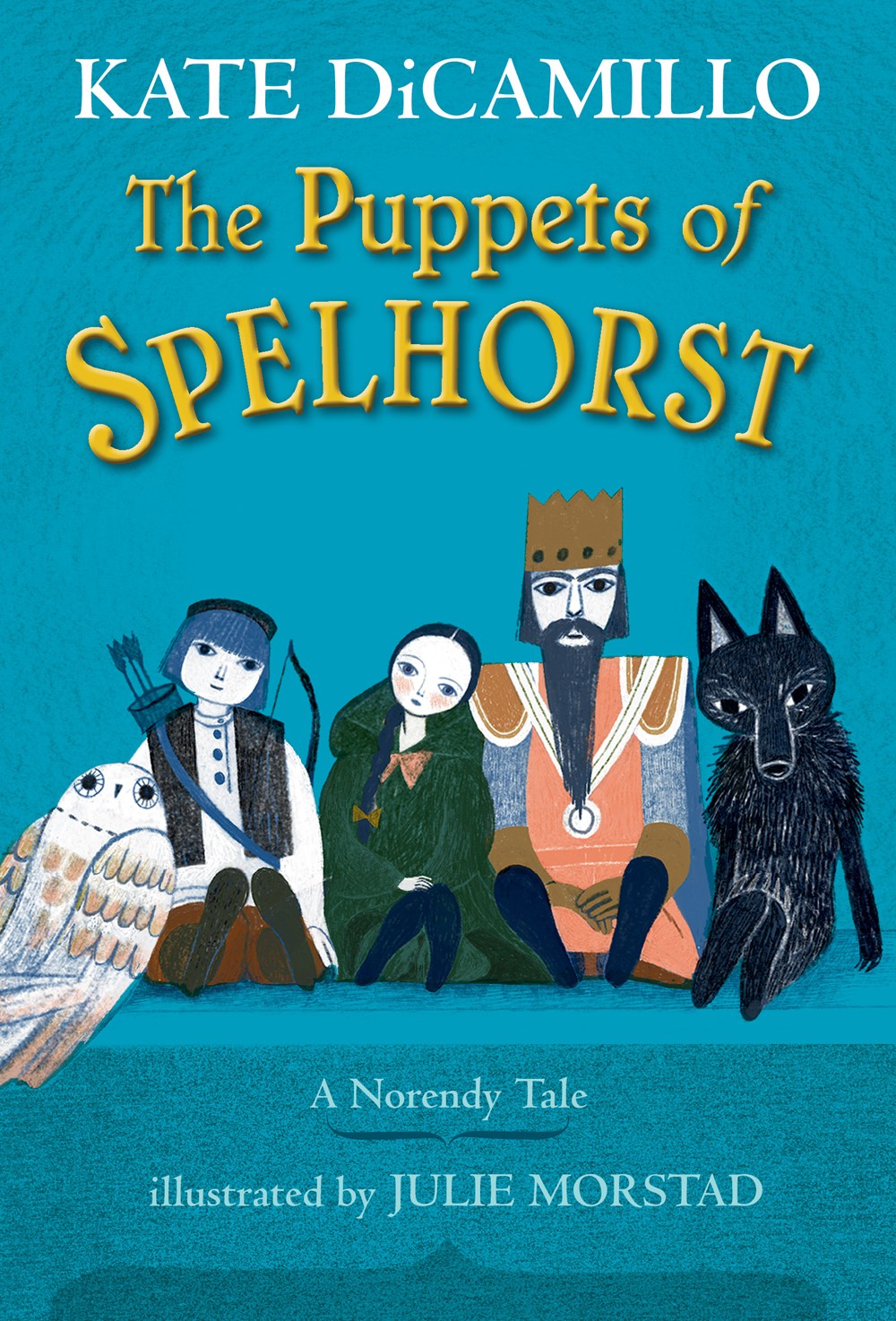 Puppets play a starring role in this first title of the Norendy Tales. Do you think kids sometimes feel as though they are being maneuvered and manipulated by forces outside their control?
Puppets play a starring role in this first title of the Norendy Tales. Do you think kids sometimes feel as though they are being maneuvered and manipulated by forces outside their control?
Oh, most definitely. I mean, I felt that way--I just remember a feeling of powerlessness, of having no agency. Sometimes I still feel that way. But telling a story, being told a story--that gives me a feeling of meaning and purpose.
Feminism, or at least girl power, seems to sneak quietly into a lot of your books. What role do you think children's fiction plays in the advancement of social issues?
I would like to think that stories help us see the world more clearly and with more compassion. We know for a fact that stories develop empathy. And for things to change (the advancement of social issues) we need to be able to imagine our way into other lives.
Every one of the characters in The Puppets of Spelhorst could be someone we know. The king puppet, for example, wants to rule, at all costs. Like a toddler, he proclaims, "I command that someone make something happen. Immediately." Do you take surreptitious notes on everyone you meet?
Ha. You made me laugh out loud. I don't take surreptitious notes on everyone I meet, but I am always paying attention--listening, watching--to the people around me, and to my own complicated heart.
The wolf puppet is guileless in her violent tendencies, like yet another toddler. Why is (younger sister) Martha so fascinated by the wolf? And why does she try to extract the wolf's fangs?
Those teeth! They are well and truly sharp! There is something fascinating about those teeth. They bespeak power and purpose, and I think that is why Martha is so fascinated by them.
Both the old sea captain and the boy puppet are stubborn and a bit heedless in their desire to seek "glory and fame" (the old man) or to "do a great deed" (the puppet) despite their effect on the lives of those around them. Why is this theme important to you?
Oh--themes. I never really see the themes in a story I tell until readers point them out to me. So, I guess I would say that I am preoccupied (as a writer) with how we move through the world--how what we want intersects with what other people (or puppets) want, and how we can find community despite, or because of that.
Jane Twiddum, the maid, is sort of a surprise star, perhaps Best Supporting Actress. How much of that was planned by you (and how much by her)?
I love that you give the credit for Jane Twiddum's fate to Jane herself. That's exactly right. I planned none of that. I was surprised and delighted by Jane's actions.
Destiny and possibility loom large in The Puppets of Spelhorst. How do you think the two concepts play together?
That's a complicated question (come to think of it, they've all been kind of complicated--which is good! I'm really using the old noggin here). I think we don't necessarily know our destinies (see Jane Twiddum) but we need to remain open to the possibilities, always.
What did you think you might learn while writing this book? What did you actually learn?
I don't know that I sat down thinking that I would learn something. Rather, I just thought, "Oh, there's a story with this owl puppet and this wolf puppet. Let me see if I can tell it." But then, everything that happened surprised me. And what I learned from Jane Twiddum (it's all about Jane Twiddum) is it is never too late to become who you are.
What was your process working with Julie Morstad? Do you have a favorite illustration in the book?
Julie's artwork knocked me off my feet. It is so perfect, so absolutely right. But (Jane, again) that last picture in the book? It takes my breath away. My editor and Chris Paul (who designed the book) communicated with Julie. I would get to see sketches as she did them, and I commented on them--but mostly what I did was say, "Oh, swoon, that is perfect. Oh, that is divine. Oh, that is just exactly as I hoped it would be."
Why don't you shy away from using big words (enterprise, portentousness, wondrous, bedraggled...) for young readers?
I love words. And as a kid, I learned so many words through reading stories. Every time a writer trusted me enough to give me a word I didn't know, I felt seen. I like giving that gift to readers.
Do you ever imagine your characters from different books interacting with each other?
WOW! What a beautiful question. I can feel myself tumbling down the rabbit hole of possibilities. I've truly never thought about that before--talk about stories nesting within stories!
Any hints about what we can expect from future titles in the Norendy Tales?
Um... magic, possibility, adventures. How's that?
Book Candy
Book Candy
A new collectible 50p coin, featuring one of Pauline Baynes's illustrations for The Lion, The Witch and the Wardrobe by C.S. Lewis, has been issued by the Royal Mint, Sky News reported.
---
Netherward, for example. Mental Floss pointed out "21 old and odd directional words."
---
"Carl Jung on the power of Tarot cards: They provide doorways to the unconscious & perhaps a way to predict the future." (via Open Culture)
---
CrimeReads investigated how Jeffery Deaver "went from publishing the wrong novels to writing his breakout thriller," Manhattan Is My Beat.
Sword Catcher
by Cassandra Clare
"There has always been magic." This perfectly captures the essence of Sword Catcher, the first book in Cassandra Clare's (Shadowhunter Chronicles; Clockwork Prince) new epic adult fantasy series. Indeed, there is magic in some form everywhere within these pages, from the spellbinding world-building of the city of Castellane to the magic system practiced by the small, isolated community of the Ashkar. In this thrilling story, Clare whisks readers away to a world of decadence and conspiracy, where most characters have one thing in common: a desire for power and wealth.
The "Sword Catcher" in the title refers to Kel, an orphan torn away from all he knew and brought to the city's castle to be the body double for the young prince, Conor Aurelian. The first part of the novel follows the two boys as they grow up together, becoming as close as brothers. Kel's future, had he stayed in the "Orfelinat," or orphanage, would have culminated in a lowly fate: "He could scrape by as a lamplighter, or a ship's boy if he was lucky, and would be poor as dirt." Instead, as Sword Catcher, he would live in the Palace and have whatever he desired. The only catch is that, through the use of talismans and charms, he would be made to look like the prince and might need to sacrifice his own life to protect his royal counterpart.
Kel soon comes to realize that the world of the palace is filled with shifting alliances, shadowy secrets, and political maneuverings. In addition to these intrigues, readers are introduced to the criminal underworld of the "pickpockets of the Warren"; the "well-known tale in the Maze about the Ragpicker King, the most famous criminal in Castellane"; and the walled area of the Sault, where the Ashkar live. Clare gives these groups complex, detailed histories and mythologies--their cultures feel layered, vibrant, and alive. She is well-known for character diversity in her stories, and the world of Castellane does not disappoint in this regard. With the Ashkar, she has showcased an under-represented culture in the fantasy genre by including elements from Jewish traditions, such as the wisdom of the Sanhedrin.
An assassination attempt in the royal court brings Kel and Lin Caster, a female physician and member of the Ashkar, together as they navigate a network of secrets and conspiracies. Behind the scenes, the enigmatic and dangerous overlord of the underworld, the Ragpicker King, oversees and orchestrates events with subtle, wily charm. Clare's perfectly paced plot--with exciting action sequences, forbidden romance, and cloak-and-dagger machinations--propels the action forward, drawing readers deeper into the web of mysteries and secrets in which Kel and Lin find themselves.
Through Kel's story as a forcibly displaced orphan whose new sole purpose is to give his life for another, as well as Lin's experience as part of the Ashkar community whose members are ostracized for their ability to use magic, important themes are addressed--identity, prejudice, and belonging. Lin thinks of herself as "knowably, clearly, Ashkar--alien in a way the sailors who thronged the port of Castellane simply weren't. Travelers had a clearly delineated role and place. The Ashkar did not." Lin also must deal with the inequity of women in a religious society. She questions the status quo: "for a religion that purports to worship a Goddess, who was once a powerful Queen, there are a great many men making decisions about what I, a woman, can read and do."
The magic system Clare creates is fascinating, with events in the past contributing to a world where all magic has been erased, except for the "small spells and talismans of gematry, the ancestral magic of the Ashkar." She also does an incredible job of building an immersive world, from the landscape and architecture to the embroidery on sumptuous clothing. Readers, and Kel, are first introduced to Castellane with this imagery-rich portrayal of the city as "huddled in the bottom of the valley like a hedgehog reluctant to poke its nose out of the safety of its lair."
Throughout the novel, each detail is meticulously and elegantly crafted--nothing overlooked--so that the world of Castellane and the Ashkar tantalizes and teases every sense, as in this evocative description of a library: "These books were as beautiful as the sun sinking behind Tyndaris. Kel could smell the scent of the leather that bound them, the ink on their pages, the bitterness of the stamping mill where the paper was made." Clare's characters are written with nuance, wit, and depth, making them relatable and likable. This, coupled with the breathtaking world that she has created, will leave readers yearning to return to Castellane, and soon, for the conclusion of this grand and twisty adventure. --Grace Rajendran
Building the Worlds We Long to Visit
An Interview With Cassandra Clare
 |
|
| (photo: Sharona Jacobs) | |
Cassandra Clare (Clockwork Prince) is the author of the bestselling Shadowhunter Chronicles. She is also the co-author, with Holly Black, of the fantasy series Magisterium. With more than 50 million copies in print worldwide, her books have been translated into more than 35 languages. Shadowhunter Chronicles has been adapted as both a major motion picture and a television series. Sword Catcher, coming from Del Rey on October 10, 2023, is the first book of a new epic fantasy series for adults, featuring Kel, the titular Sword Catcher, a look-alike for the prince who serves as the royal's decoy as he navigates the magical world of Castellane and its subcultures.
What influenced your move into the adult fantasy genre, and what were the main differences between writing for the YA market versus for adults?
It wasn't a conscious choice to move into the adult space. It was more that the idea came to me, and as I developed it, I began to realize it was an adult story. I think people often imagine there are very specific differences between adult and YA writing that they can identify immediately, but that's not my experience. If, as in Sword Catcher, their interests and conflicts--marriage, jobs--tend older, then the book is typically adult. And Sword Catcher is very much about people who are looking at things like getting married and what they want to do professionally. Where it comes to Conor and Kel's relationship, especially, it's about two people who were incredibly close as children and now, as they have become adults, that friendship changes shape in ways that threaten it.
Sword Catcher is not part of The Shadowhunters universe. What was the funnest part of creating a totally new world and set of characters for this series, and what were your greatest challenges?
I think a lot of people think of Shadowhunters as one long series, but it's actually a universe of connected trilogies and short stories. For each trilogy I've had to invent a new cast of characters, so that's not something new to me. Usually characters are what come to me first, and the story and the world comes later. It was the same with Sword Catcher. The characters came first, and the concept of the Ashkar and the job of Sword Catcher. The Ragpicker King is a character I used to write about before I was published, and it was really fun to be able to reach back and pull him forward into this story. I'd say my biggest challenge was getting over the fear that adult fiction was something I couldn't write or wouldn't know how to do, or that my existing readers would reject Sword Catcher because it's so different than Shadowhunters or Magisterium. But in the end my love for the story pulled me through the hard parts!
How has your love of travelling inspired the world-building in Sword Catcher?
I traveled a lot with my parents when I was a child. I was an only child, so it was a lot of amusing myself in foreign places. It made me love travel. I love being somewhere that feels different than home, I love new customs and cultures, and especially the way cultures are porous, and blend into each other via travel and trade. I was always interested in the Silk Road, and the way it connected a diversity of people and cultures; Castellane is a city that exists at the crossroads of Silk Road-style trade, and thus is very far from monocultural. I've also always been interested in how long people have traveled for pleasure and adventure--people tend to assume modern tourism started in the 1800s but travelers were writing guidebooks long before that. One of the texts I relied on was Ibn Battuta's A Gift to Those Who Contemplate the Wonders of Cities and the Marvels of Travelling, which was written in the 1300s and covers his travels and everything he found amazing about exploring the world.
The evocative descriptions of the city, from the clothing to the food, create an immersive experience that brings Castellane to life. What can you tell us about your research process?
It was extensive! I spent about five years researching for this book--not without interruptions for other things!--because I wanted to make sure Castellane felt like a layered, textured place. It's a Mediterranean climate, so I spent time researching the kinds of plants that grow in those places, and when they bloom and how they'd scent the air, and what people would use them for. Lin is a doctor, so I researched the history of medicine and medical instruments to figure out what kind of drugs she'd prescribe, and what kind of operations she could do. I didn't want a character to take a drink from a bottle of liquor, but from a bottle of jenever or pastisson (a fictionalized version of pastis or absinthe). I didn't want someone to put on shoes, but to put on a pair of boots designed and incised a particular way. I wanted to show how the food that the Ashkar eat is different from Castellani food, which is different from the food of Marakand. I always feel like specificity goes miles in establishing the texture of a world, and a lot of research goes into all of that.
Sword Catcher is filled with nuanced, diverse characters. Why is this important to you and how do you avoid drawing on stereotypes when crafting your characters?
I tend to stick with the best advice I've been given, which is to write from your own experience when you can and research, research, research when you can't. (With research also meaning that absolutely you should consult with people from marginalized communities not your own if you're representing that marginalized community in your work. I had multiple sensitivity readers who worked with me on Sword Catcher and it was immensely helpful.)
Part of the reason Sword Catcher, with the Ashkar, focuses on Jewish mythology and historical Jewish experience is because, as a Jewish fantasy fan, I always had trouble finding literature that represented my experience and history. There are a lot of Jewish writers--but we almost never get to write about ourselves or our own experience. I want Jewish readers to be able to see references to things like the Sanhedrin, certain prayers centering around everything from hand-washing to mourning, even specific colors, and be able to relate that to their knowledge and experience.
What do you think readers of your Shadowhunters books will love the most about this new series?
The characters, I hope! I always feel like releasing a new book to my readers is like introducing mutual friends. Suddenly we all inhabit the same space together. I think those who love the Shadowhunter books and find in them characters they can relate to, will find the same here--from Lin and her stubbornness, to Kel and his devotion to Conor, to Conor and his mischief, to the Ragpicker King and his cunning plans, to Ji An and her sharp sense of humor. I look forward to being able to talk about these characters, who have lived in my mind for so long, with my readers when the book comes out. --Grace Rajendran
Rediscover
Rediscover: Eve Bunting
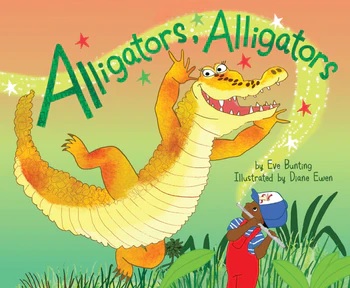 Eve Bunting, the author of more than 250 books for young people whose career spanned 50 years, died October 1 at age 94. Bunting's works ranged from charming, rhyming animal stories and Irish folk tales to more serious titles focused on socially conscious topics such as homelessness, displacement, and environmental concerns. Many have been translated into multiple languages. Her latest work, Alligators, Alligators (2023) was published this past August by Clarion Books.
Eve Bunting, the author of more than 250 books for young people whose career spanned 50 years, died October 1 at age 94. Bunting's works ranged from charming, rhyming animal stories and Irish folk tales to more serious titles focused on socially conscious topics such as homelessness, displacement, and environmental concerns. Many have been translated into multiple languages. Her latest work, Alligators, Alligators (2023) was published this past August by Clarion Books.
Born in Northern Ireland in 1928, Bunting was frequently asked as a child to give oral recitals of verse and biblical writing, which developed a sense of language and rhyme that sustained her through the many talks, addresses, and readings she gave at conferences and libraries throughout her career and in the writing courses she taught. In 1958, she moved with her husband and three children to California, where she began her writing career in her 40s after participating in a local community college writing course.
As a picture book author, Bunting worked with many gifted illustrators. Her first book, The Two Giants (1971), was illustrated by Eric Von Schmidt, and over the years she collaborated with many other illustrators, including Jan Brett, Lauren Castillo, David Diaz, Ronald Himler, Emily Arnold McCully, Wendell Minor, Barry Moser, Sergio Ruzzier, Chris Soentpiet, and David Wiesner.
She was an active member of several professional writing groups, including her beloved "Lunch Bunch" in Southern California. For years, she was on the Society of Children's Book Writers and Illustrators board of advisors. Her literary papers and books are archived at the Kerlan Children's Literature Research Collection at the University of Minnesota.
Her many honors include the Kerlan Award, the Jane Addams Children's Book Award, the Arab American Book Award, the Western Writers of America Award, the Southern California Council on Literature for Children and Young People Award, and a PEN Los Angeles Center Special Achievement Award for her contribution to children's literature.
In addition, she was presented with the SCBWI's Golden Kite Award for One More Flight (1976), the Edgar Award for best juvenile mystery for Coffin on a Case (1991), and the Regina Medal in 1997 from the Catholic Library Association. Bunting is also author of the Caldecott Medal-winning Smoky Night, illustrated by David Diaz (1994). A PBS production, Reading Rainbow: The Wall, inspired by Bunting's book The Wall (1990) and presented by LeVar Burton, was a Peabody Award winner.
"Through these books and many more, Eve captivated readers with gentle, emotionally honest stories that reflected her warmth, humor, and deep respect for young people. Many of them are now considered classics," said her publisher, HarperCollins Children's Books, adding: "Eve had a full and happy life filled with love and many personal achievements, and she leaves behind joyous and loving memories for her family, and a legacy of wonderful books for all children to enjoy. Her writing and spirit will live on with each new generation of young readers."


